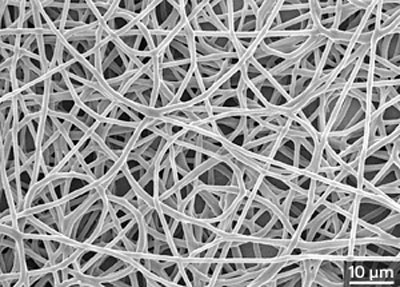| Dec 22, 2010 |
Biomaterials: Close to the bone
|
|
(Nanowerk News) Osteoporosis, or bone deterioration, is a public health problem that affects one in three women and one in 12 men over the age of 50. Patients with osteoporosis have fragile bones and are at risk of hip, wrist and rib fractures. Tissue engineering, which uses stem cells, growth factors and scaffolds—porous structures for supporting cell proliferation, differentiation and tissue formation—to generate new body tissues, is an attractive method for repairing fragile or fractured bones. However, the technology is still at its infancy and there remain a number of hurdles to overcome.
|
|
In tissue engineering, the use of scaffolds that mimic natural extracellular matrixes can greatly enhance the quality and success of tissue formation. Li Xu at the A*STAR Institute of Materials Research and Engineering and co-workers have now developed a series of copolymers for fabrication of scaffolds that mimic the mechanical properties, surface chemistry and porosity of the extracellular matrix of human bone ("Designing Poly[(R)-3-hydroxybutyrate]-Based Polyurethane Block Copolymers for Electrospun Nanofiber Scaffolds with Improved Mechanical Properties and Enhanced Mineralization Capability"). The scaffolds are biodegradable and absorb water and calcium minerals well, making them ideal for bone regeneration.
|
 |
| Scanning electron microscopy image of a porous copolymer scaffold.
|
|
Polyhydroxybutyrate (PHB) is a biocompatible, biodegradable and readily available polymer produced by bacteria. However, PHB is rarely used as a scaffold material because it is brittle and hydrophobic. Xu and his co-workers made PHB ductile and hydrophilic by incorporating segments of polyethylene glycol (PEG) into the backbone of PHB. They then used an electrically driven technique called electrospinning to weave PHB–PEG copolymer fibers into porous structures (pictured).
|
|
Tensile measurements revealed that the developed copolymers could be strained up to 20 times its original length before failure. Laboratory tests showed that the flexible and porous copolymer scaffolds could absorb water much better than PHB scaffolds and retain their structural integrity throughout cell culture work.
|
|
When small pieces of the porous structures were immersed into a pool of 'simulated body fluid' containing various salts, including sodium chloride, calcium chloride and disodium hydrogen phosphate, the researchers found that the porous structures could soak up the salts and undergo mineralization without further surface modification— facilitating the formation of an extracellular matrix much akin to human bone.
|
|
"Scaffolds made using the new PHB–PEG copolymer may become useful for bone generation, and hence improve the quality of life of osteoporosis patients," says Xu. In addition, the co-polymers are biocompatible and biodegradable, and should therefore cause little transplant rejection in patients. He and his co-workers believe their technique may also be extended to other types of tissues.
|

